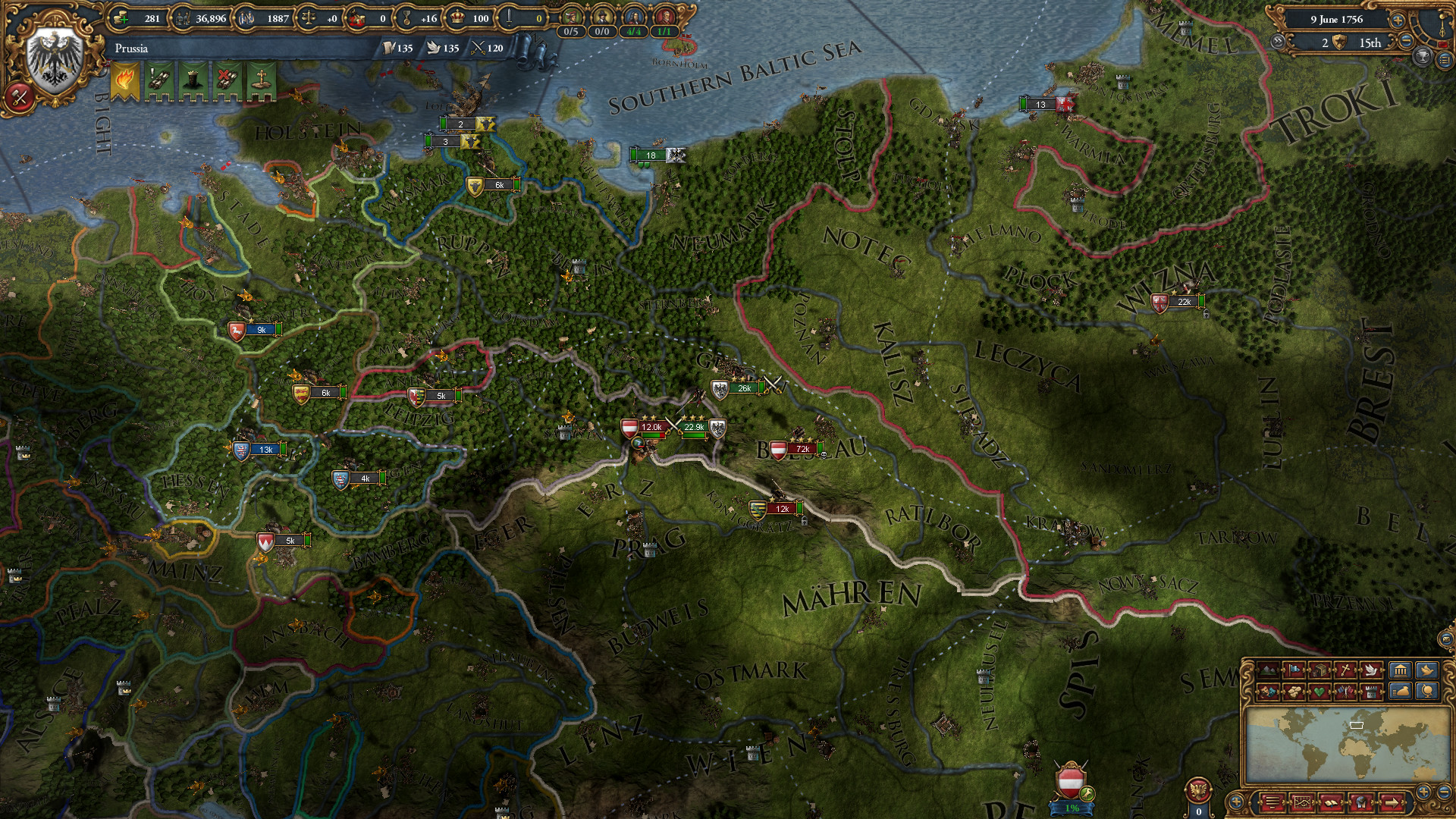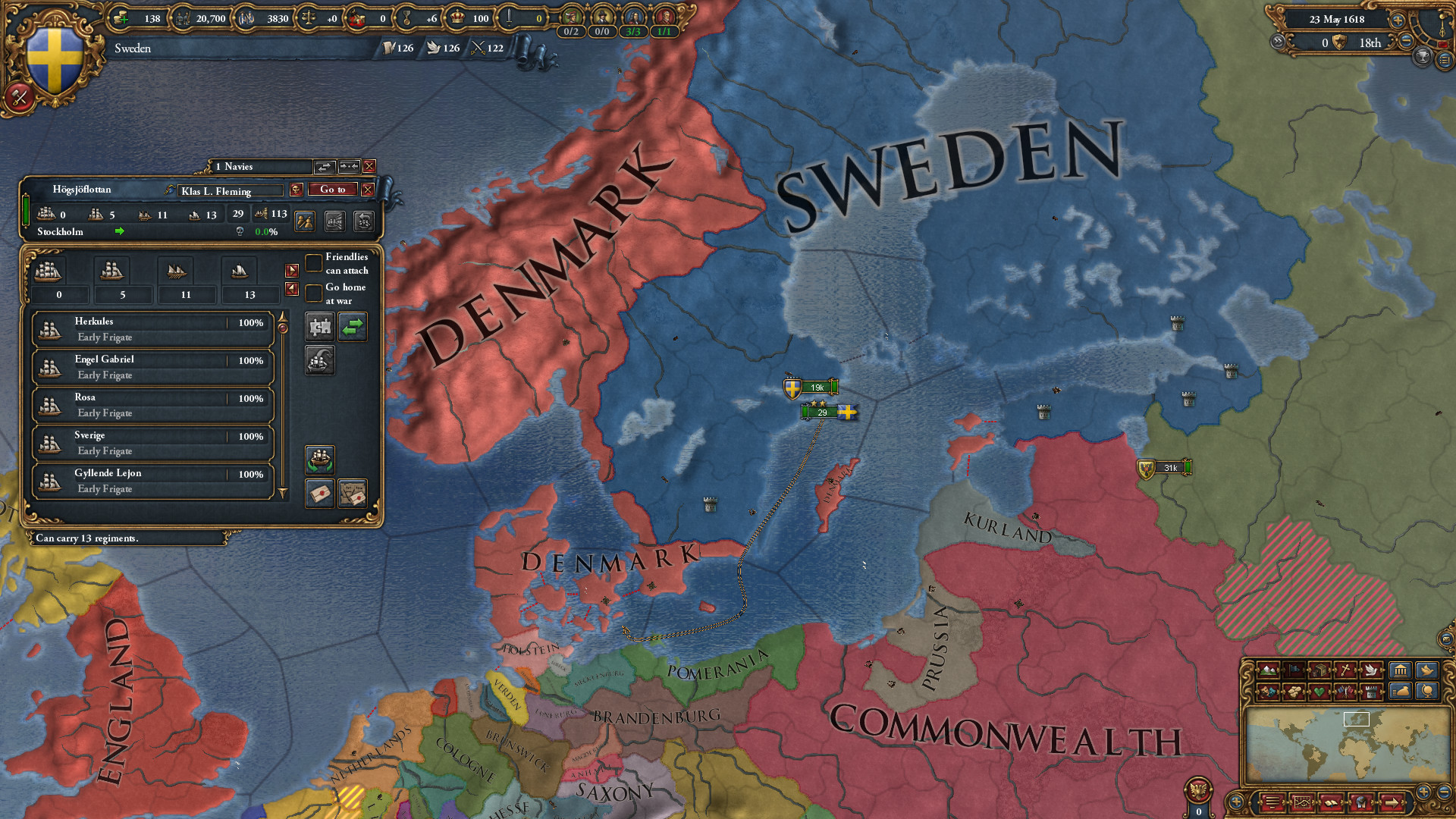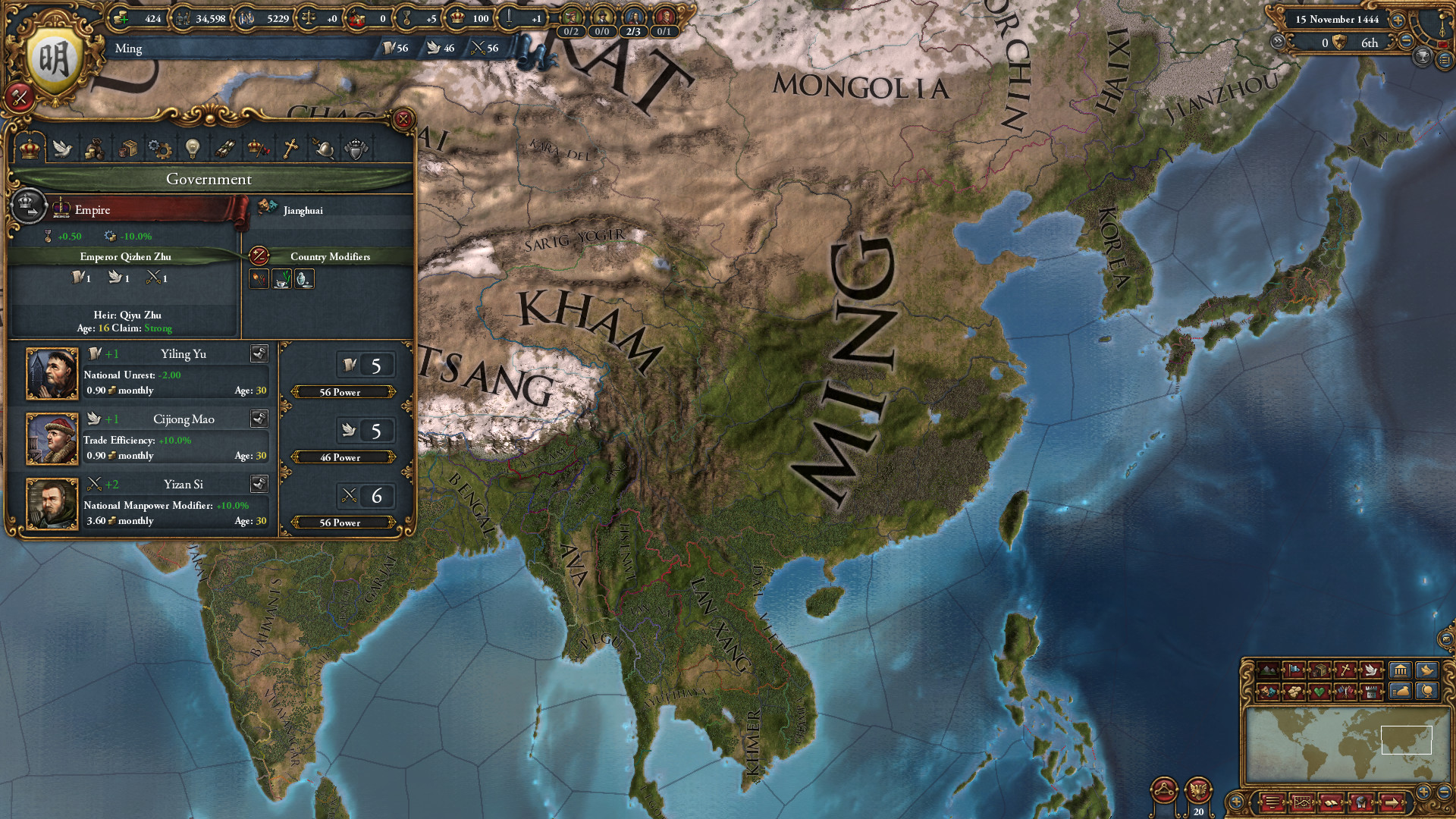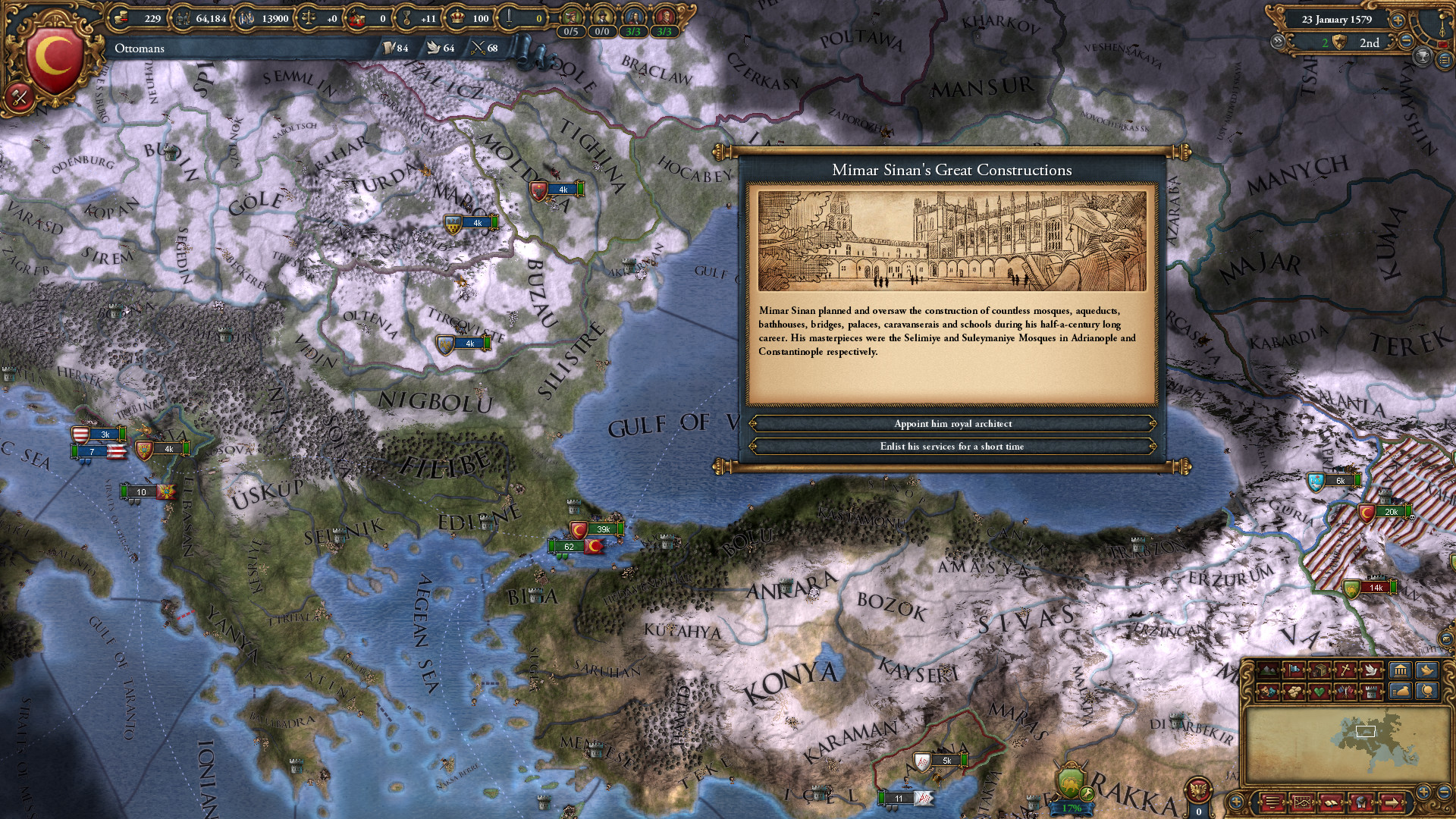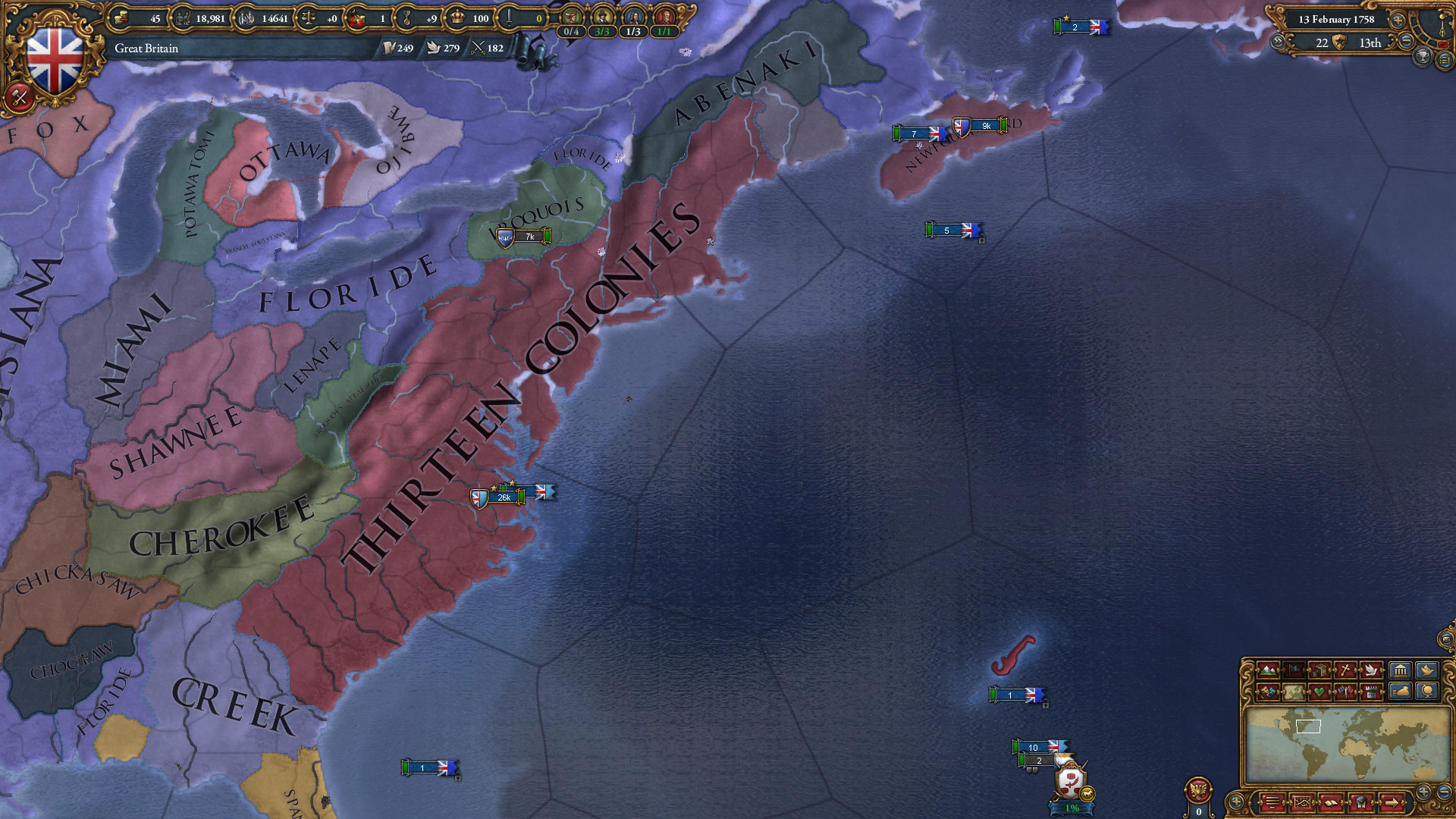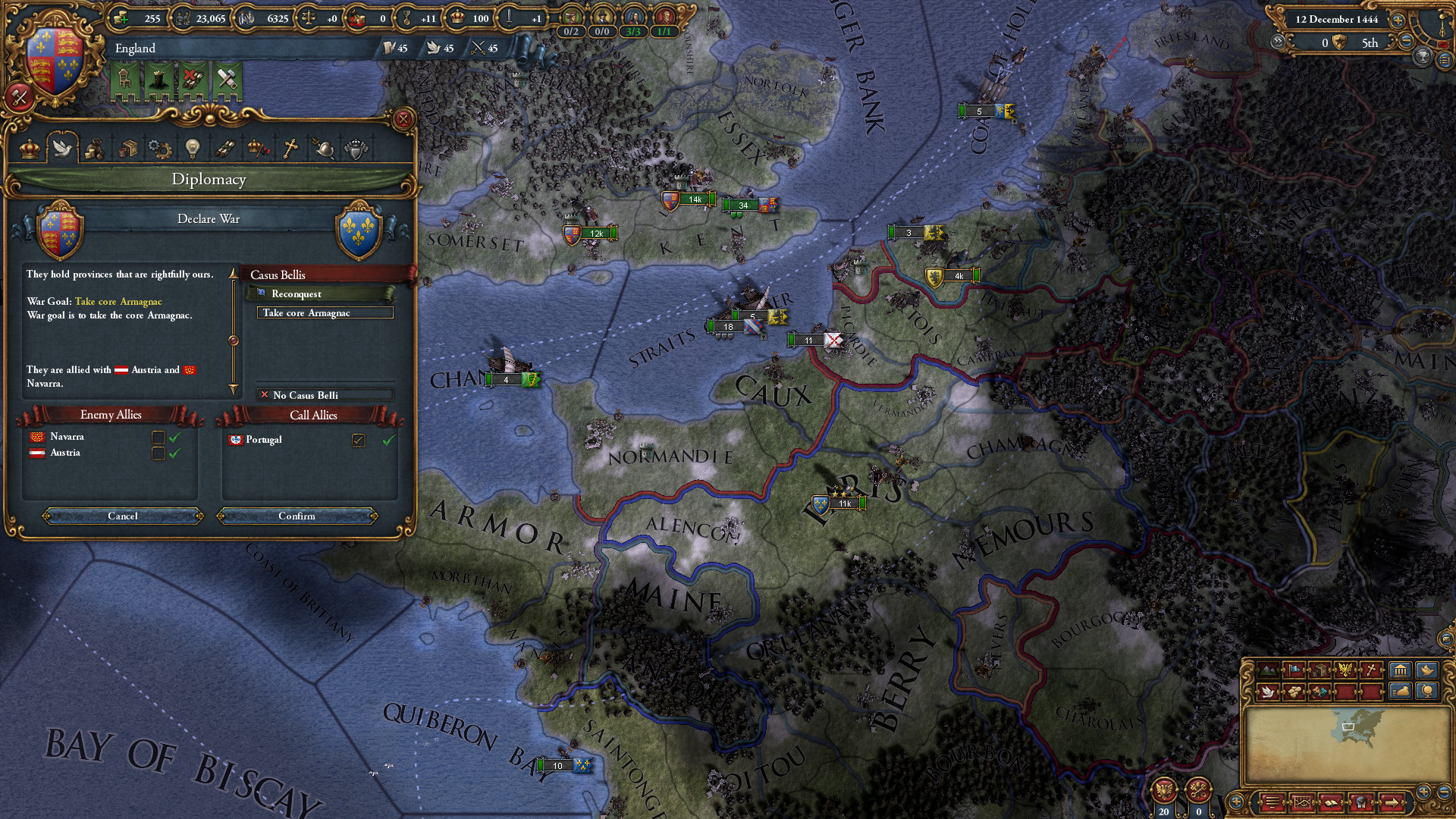Fulfill Your Quest For Global Domination
Paradox Development Studio is back with the fourth installment of the award-winning Europa Universalis series. The empire building game Europa Universalis IV gives you control of a nation to guide through the years in order to create a dominant global empire. Rule your nation through the centuries, with unparalleled freedom, depth and historical accuracy. True exploration, trade, warfare and diplomacy will be brought to life in this epic title rife with rich strategic and tactical depth.
Paradox Development Studio is back with the fourth installment of the award-winning Europa Universalis series. The empire building game Europa Universalis IV gives you control of a nation to guide through the years in order to create a dominant global empire. Rule your nation through the centuries, with unparalleled freedom, depth and historical accuracy. True exploration, trade, warfare and diplomacy will be brought to life in this epic title rife with rich strategic and tactical depth.
Main Features
- Make your own decisions: Nation building is completely flexible and the possibilities are endless.
- Use your Monarch Power: Experience the new system of monarch power where your choices are influenced by the caliber of the man or woman you have at the top and will direct the ebb and flow of gameplay.
- Experience history coming to life: The great personalities of the past are on hand to support you as you make your mark on thousands of historical events.
- Turn the world into your playground: Enjoy hundreds of years of gameplay in a lush topographical map complete with dynamic seasonal effects.
- Experience the all new trade system: The trade system adds a new dimension to the great trade empires of the period. Gain control of vital trade routes and make the wealth of the world flow to your coffers.
- Bring out your negotiating skills in a deeper diplomatic system: Use coalitions, royal marriages and support for rebels and explore the possibilities of the new unilateral opinion system.
- Engage in Cross-platform Multiplayer: Battle against your friends or try the co-operative multiplayer mode that allows several players to work together to control a single nation with up to 32 players. Featuring improved chat and new matchmaking servers.
- Create your own history & customize your game: Europa Universalis IV gives you the chance to customize and mod practically anything your heart may desire and uses Steam Workshop.
EU4 Dev Diary - Venice, The Netherlands, and Italy.

The new content for Venice comes packed with a tree armed with lots of new missions. These will branch and cover various aspects of the Republics history, ranging from the Italian wars, conquests in the peninsula and beyond, to maritime expansionism, internal development, the cultivation of the arts and culture, and even colonization. But wait, theres more! Venice also now has access to a brand new government mechanic, the Council of Ten. Alongside that, the narrative of your game will be enhanced with the introduction of new events around Venices (and her peoples) most celebrated accomplishments ranging from theatre to Titian and the Loredanian Academy.
Starting off, the upper third of the tree will be focused on internal matters, starting with the introduction of the Council of Ten, your primary adversary in domestic affairs:

Note: Note: Historical insights is one of the grand themes of the content around Venice, showing the whys and the hows of various political, military and cultural events!

Note: ALL ART in this Developer Diary is placeholder.
Opposed to the Doges influence and attempts to lead Venice into wars or even autocratic rule, the Councils Authority for Venice will commence at around 90%, placing the Doge in a difficult position. Throughout your play through, this mechanic will have a prevalent spot in your decision-making, and be affected by the various generic and unique events that may occur as well as mission rewards and interactions. Should the councils authority surpass the 90% mark, it will forbid the Doge from commencing any offensive wars and have further severe repercussions, as shown above.
It is worth noting that a council would be more compliant and at ease, should the Doges stats are low, whilst a competent Doge will cause the Council to react, increasing its authority passively.
The three interactions tied to the Council of Ten are a representation of the ruling faction and its abilities. Venice has access to the Aristocrats, the Traders, and the Guilds. Each interaction is an exchange between the Doge and the faction in power. You grant them crownland and political power. In return, you may gain powerful short-term benefits:
Both the Aristocrats and Traders will demand crown land for their respective estate alongside monarch power, whilst the Guilds will demand Republican Tradition alongside monarch power. In return they will grant a great variety of bonuses that allow for versatility, from development in the capital, to government reform progress and even marines or galleys in Venezia. Along with the aforementioned grant of ships, troops, or development, the interactions will also lower the authority of the Council, with each faction having unique interactions available.
Moving on, a substantial amount of this branchs missions are associated with historical events, showcased through their rewards:

Note: The second option grants the same reward. It goes into detail about Venice, architecture, and the Renaissance for those who wish to learn more about it!

Here are a few other missions and their associated rewards from the first part of the content:

The culmination of this branch ends with the event:


Note: Changed your mind after having the event and want your old colour/name back? You can do so with the Restore our Name / Restore our Colour national decisions!
And here are the ideas of the Golden Republic:
[code]LNS_ideas = {
start = {
trade_steering = 0.33
galley_power = 0.25
}
bonus = {
discipline = 0.05
}
trigger = {
tag = VEN
NOT = { has_country_flag = ven_upgrade_state_inuisition_idea_flag }
}
free = yes #will be added at load.
lns_renaissance_art = {
technology_cost = -0.1
}
stato_da_mar = {
#Present in the previous VEN_ideas ideaset
}
lns_maritime_dominance = {
global_trade_power = 0.2
}
lns_a_gunpowder_republic = {
fire_damage = 0.15
land_forcelimit_modifier = 0.2
}
backing_of_the_ducat = {
naval_forcelimit_modifier = 0.5
}
reform_the_uscocchi = {
global_ship_trade_power = 0.35
global_trade_goods_size_modifier = 0.1
}
maggior_consiglio = {
max_absolutism = 10
max_revolutionary_zeal = 10
}
}[/code]
The second branch will deal with the outward expansion of the Republic, and the various fronts in Italy, the Mediterranean and beyond. Early on you will be tasked with choosing the specialization of your military, with options that range from favouring the land army, to favouring the Navy or Mercenary groups.
The Standing army branch will imbue your selection of current Military advisor with a powerful permanent bonus, as shown below:

Note: Hmm, maybe that Siege Ability needs some nerfing, 3%? What do you think?
The second mission will grant an interesting modifier for Venice:

The Mercenary path will improve the effectiveness of its associated Militarization mechanic and grant access to a unique new decision, turning Venezia to the administrative capital of your mercenary army:

The final possible path, focused on the Navy:

The conquest path involves many avenues for expansion, events and interesting modifiers:


The final branch follows an alternative-history path of Venice spreading its mercantile and maritime grasp beyond the Mediterranean, with routes to Aden, India, China, and even the Americas:

Finally, Venice has access to the Into the Red Sea mission which may facilitate and accelerate the construction of the Suez Canal in the Red Sea, allowing access to their fleets for exploration, conquest and trade purposes. The mission will require cooperation and alliance with the Mamluks, and the breakdown of diplomacy between the two countries will restore the Mamluk cores in the two associated provinces, leading to war:

As in the Emperor variation, the mission tree places much focus on the restoration of the Roman Empire, unification of Italy both politically and economically and reforming the military. Besides that, there is a subtree concerning continuing renaissance and a branching mission tree about which of the two
end-nodes you choose to favour.
Structure-wise, the mission tree is quite similar to that of Byzantium, not just in the general theme of Roman Restoration, but also in the way it is designed. The mission tree makes use of evolving modifiers, incrementally building up the "permanent modifier" that is the reward for your efforts. Later missions in the conquest offer age-timed modifiers, encouraging swift and relentless conquests.
Get those modifiers while you still can!
The leftmost branch about Risorgimento forces you to develop your core territories in Italy Region and to
unite it politically. At the end of this tree, you shall claim your spot as one of the Great Powers:



The mission tree also has 3 missions about your military, starting with a possibility to maintain a Condottieri-based army then tasking you with modernizing the Galleass (increasing their available amount, their fighting power or allowing them to transport troops) and upgrading your Alpine defences. Here's the "Adapting Our Military" mission reward:

Before we move on, the other mini-branch left between us and the economic missions concerns the Renaissance. Your first mission tasks you with developing the Birthplace of the Renaissance (in this case Lucca) 10 times and requiring you to be ahead of time in all technologies:


Lastly, the missions about Economy & Trade, beginning with Economy. This portion of the mission tree is concerned with achieving parity between the economies of the north and south while also pushing Italian goods onto the world markets. Notable is also the inclusion of Camillo Benso Cavour as an Statesman advisor, who, while outside of the game's time frame, we found fitting to include due to his role in the Risorgimento and early politics of Italy.


Finally, the branching missions about trade. In order to get started, you need to gain a sizeable trade income of 300 Ducats, 30 Centers of Trade and 3 Trade nodes with at least 80.0% trade share, the reward mainly giving you the ability of to select your new mission tree:

Besides the mission tree you choose, your choice will also have an impact on the privilege you just unlocked! Let's go over the two branches, beginning with the Venetian branch, focusing on funnelling the trade from the near and further east to the markets of La Serenissima:

The Venetian Supremacy focuses on establishing the Venice trade node as the richest in the World and with at least 150 Trade Node Value, something you will probably be close to. "Eastern Markets" force you to dabble in the affairs of the Eastern Mediterranean, gaining 80% Trade Share in Egypt, Aleppo and Constantinople. Lastly, "The Journey to the East" requires you to build the Suez Canal and to funnel the trade from the West Coast of India through the Gulf of Aden, here's what rewards that brings you:

Let's explore the Genoese branch now:

This mission tree is in many ways analogous to the other one. "Western Favoritism" is the same as "The Venetian Supremacy" but refers to Genoa instead. "Plus Ultra" requires 80% trade share in Tunis, Valencia, and Sevilla. "The Italian Discovery" is all about creating a Colonial Empire in the New World. Here's what you might expect:



After unifying most of the Low Countries, and completing the above missions, youll be able to form the Netherlands earlier than usual. This was done in order to not block the player from getting access to the rest of the content, and continue on a flow of gameplay, uninterrupted by artificial barriers. The mission "Je Maintinendrai" will alleviate the Administrative Tech 10 requirement and grant you a bonus to your development cost, discipline and valuable claims to solidify your borders across the Low Countries region.


Later on in your campaign, when you hit tech 20, should you have England or Great Britain as a Personal Union still, youll be able to form the United Crowns nation, with a unique colour, as well as unique ideas, as shown below.

Note; This will also be available in the base game
The ideas shown above (barring the traditions and ambition) are a pure mixture of the two nations and as the United Crowns, you will have access to the flavour of Great Britain, England and the Netherlands (such as events).


However, as impressive as the above may be, the primary focus of the Dutch military lay within its navy. From the Five Admiralties, which all had their own interests, to their all-purpose Flyut Vessels, to their grand admiral Michiel de Ruyter. The Dutch naval flavour focuses on dominating trade and crushing your maritime rivals, establishing an empire that rules throughout the oceans.



Note: We opted to go for a light version of the typical Dutch colour.

There are now more ways to play with Dutch factionalism. New Government Reforms have been added for the player to take sides with the Statists or the Orangists. There is also a small branch dedicated to this conflict between those two factions, and the rewards there depend on which one you decide to side with, maybe eat an opposing prime minister or two whilst youre at it.


Note; This event will be part of the base game.
Lastly, the Netherlands now has more events, most of them revolving around Great Men and a few about some other Dutch architectural feats. These will also be available in the base game and are a great way to complement an already well-fleshed-out country like the Netherlands.

Note: These Events will also be available through the base game!
Thank you for reading todays Developer Diary! We will be back next week with the countries of Austria, Germany, Hungary as well as Bohemia with Pintu!
Hello and good afternoon! Today we will be taking a look at the content we have in store for Venice, Italy, and the Netherlands. All three of these countries have many gameplay aspects in common, trade, maritime prowess, and, to some degree, colonization. Either as important proponents of history, as is the case for Netherlands and Venice, or as valuable gameplay additions in Italys case, these countries are due to receive new content with the upcoming DLC.
Venice
Reaching its apogee of power during the 15th century, the Most Serene Republic of Venice is located in the heart of maritime activity, with a strong grip on its home end node. Following an illustrious history, La Serenssima stands as one of the most influential Italian states. At the cusp of the Renaissance, the prosperity of the arts & culture gives way to the blooming and rise of new artists, architecture and traditions. To the south, the remnants of Rome are ripe for the taking, between the forces of the Republic and the Ottoman Turks. To the North, the imposing shadow of the Holy Roman Emperor as he struggles to maintain Italy in his decentralized Empire. The peninsula will soon be the home to a bloody struggle, as prospecting conquerors eye each others land with covetous greed. Venices content has been crafted with attention to detail, historicity, and the telling of a grand story around Italys most celebrated republic during the games time frame. Andiamo!
The new content for Venice comes packed with a tree armed with lots of new missions. These will branch and cover various aspects of the Republics history, ranging from the Italian wars, conquests in the peninsula and beyond, to maritime expansionism, internal development, the cultivation of the arts and culture, and even colonization. But wait, theres more! Venice also now has access to a brand new government mechanic, the Council of Ten. Alongside that, the narrative of your game will be enhanced with the introduction of new events around Venices (and her peoples) most celebrated accomplishments ranging from theatre to Titian and the Loredanian Academy.
Starting off, the upper third of the tree will be focused on internal matters, starting with the introduction of the Council of Ten, your primary adversary in domestic affairs:

Note: Note: Historical insights is one of the grand themes of the content around Venice, showing the whys and the hows of various political, military and cultural events!

Note: ALL ART in this Developer Diary is placeholder.
Opposed to the Doges influence and attempts to lead Venice into wars or even autocratic rule, the Councils Authority for Venice will commence at around 90%, placing the Doge in a difficult position. Throughout your play through, this mechanic will have a prevalent spot in your decision-making, and be affected by the various generic and unique events that may occur as well as mission rewards and interactions. Should the councils authority surpass the 90% mark, it will forbid the Doge from commencing any offensive wars and have further severe repercussions, as shown above.
It is worth noting that a council would be more compliant and at ease, should the Doges stats are low, whilst a competent Doge will cause the Council to react, increasing its authority passively.
The three interactions tied to the Council of Ten are a representation of the ruling faction and its abilities. Venice has access to the Aristocrats, the Traders, and the Guilds. Each interaction is an exchange between the Doge and the faction in power. You grant them crownland and political power. In return, you may gain powerful short-term benefits:
Both the Aristocrats and Traders will demand crown land for their respective estate alongside monarch power, whilst the Guilds will demand Republican Tradition alongside monarch power. In return they will grant a great variety of bonuses that allow for versatility, from development in the capital, to government reform progress and even marines or galleys in Venezia. Along with the aforementioned grant of ships, troops, or development, the interactions will also lower the authority of the Council, with each faction having unique interactions available.
Moving on, a substantial amount of this branchs missions are associated with historical events, showcased through their rewards:

Note: The second option grants the same reward. It goes into detail about Venice, architecture, and the Renaissance for those who wish to learn more about it!

Here are a few other missions and their associated rewards from the first part of the content:

The culmination of this branch ends with the event:


Note: Changed your mind after having the event and want your old colour/name back? You can do so with the Restore our Name / Restore our Colour national decisions!
And here are the ideas of the Golden Republic:
[code]LNS_ideas = {
start = {
trade_steering = 0.33
galley_power = 0.25
}
bonus = {
discipline = 0.05
}
trigger = {
tag = VEN
NOT = { has_country_flag = ven_upgrade_state_inuisition_idea_flag }
}
free = yes #will be added at load.
lns_renaissance_art = {
technology_cost = -0.1
}
stato_da_mar = {
#Present in the previous VEN_ideas ideaset
}
lns_maritime_dominance = {
global_trade_power = 0.2
}
lns_a_gunpowder_republic = {
fire_damage = 0.15
land_forcelimit_modifier = 0.2
}
backing_of_the_ducat = {
naval_forcelimit_modifier = 0.5
}
reform_the_uscocchi = {
global_ship_trade_power = 0.35
global_trade_goods_size_modifier = 0.1
}
maggior_consiglio = {
max_absolutism = 10
max_revolutionary_zeal = 10
}
}[/code]
The second branch will deal with the outward expansion of the Republic, and the various fronts in Italy, the Mediterranean and beyond. Early on you will be tasked with choosing the specialization of your military, with options that range from favouring the land army, to favouring the Navy or Mercenary groups.
The Standing army branch will imbue your selection of current Military advisor with a powerful permanent bonus, as shown below:

Note: Hmm, maybe that Siege Ability needs some nerfing, 3%? What do you think?
The second mission will grant an interesting modifier for Venice:

The Mercenary path will improve the effectiveness of its associated Militarization mechanic and grant access to a unique new decision, turning Venezia to the administrative capital of your mercenary army:

The final possible path, focused on the Navy:


The conquest path involves many avenues for expansion, events and interesting modifiers:


The final branch follows an alternative-history path of Venice spreading its mercantile and maritime grasp beyond the Mediterranean, with routes to Aden, India, China, and even the Americas:

Finally, Venice has access to the Into the Red Sea mission which may facilitate and accelerate the construction of the Suez Canal in the Red Sea, allowing access to their fleets for exploration, conquest and trade purposes. The mission will require cooperation and alliance with the Mamluks, and the breakdown of diplomacy between the two countries will restore the Mamluk cores in the two associated provinces, leading to war:

Italy
Whilst we are on the Italian peninsula, lets take a look at Italy herself. In line with the calibre of content featured in Domination, Italy is due to receive new and revised content. Many of the core tenets of the mission tree have been kept, but they have been revised and expanded upon, lets take a look!
As in the Emperor variation, the mission tree places much focus on the restoration of the Roman Empire, unification of Italy both politically and economically and reforming the military. Besides that, there is a subtree concerning continuing renaissance and a branching mission tree about which of the two
end-nodes you choose to favour.
Structure-wise, the mission tree is quite similar to that of Byzantium, not just in the general theme of Roman Restoration, but also in the way it is designed. The mission tree makes use of evolving modifiers, incrementally building up the "permanent modifier" that is the reward for your efforts. Later missions in the conquest offer age-timed modifiers, encouraging swift and relentless conquests.
Get those modifiers while you still can!
The leftmost branch about Risorgimento forces you to develop your core territories in Italy Region and to
unite it politically. At the end of this tree, you shall claim your spot as one of the Great Powers:



The mission tree also has 3 missions about your military, starting with a possibility to maintain a Condottieri-based army then tasking you with modernizing the Galleass (increasing their available amount, their fighting power or allowing them to transport troops) and upgrading your Alpine defences. Here's the "Adapting Our Military" mission reward:

Before we move on, the other mini-branch left between us and the economic missions concerns the Renaissance. Your first mission tasks you with developing the Birthplace of the Renaissance (in this case Lucca) 10 times and requiring you to be ahead of time in all technologies:


Lastly, the missions about Economy & Trade, beginning with Economy. This portion of the mission tree is concerned with achieving parity between the economies of the north and south while also pushing Italian goods onto the world markets. Notable is also the inclusion of Camillo Benso Cavour as an Statesman advisor, who, while outside of the game's time frame, we found fitting to include due to his role in the Risorgimento and early politics of Italy.


Finally, the branching missions about trade. In order to get started, you need to gain a sizeable trade income of 300 Ducats, 30 Centers of Trade and 3 Trade nodes with at least 80.0% trade share, the reward mainly giving you the ability of to select your new mission tree:

Besides the mission tree you choose, your choice will also have an impact on the privilege you just unlocked! Let's go over the two branches, beginning with the Venetian branch, focusing on funnelling the trade from the near and further east to the markets of La Serenissima:

The Venetian Supremacy focuses on establishing the Venice trade node as the richest in the World and with at least 150 Trade Node Value, something you will probably be close to. "Eastern Markets" force you to dabble in the affairs of the Eastern Mediterranean, gaining 80% Trade Share in Egypt, Aleppo and Constantinople. Lastly, "The Journey to the East" requires you to build the Suez Canal and to funnel the trade from the West Coast of India through the Gulf of Aden, here's what rewards that brings you:


Let's explore the Genoese branch now:

This mission tree is in many ways analogous to the other one. "Western Favoritism" is the same as "The Venetian Supremacy" but refers to Genoa instead. "Plus Ultra" requires 80% trade share in Tunis, Valencia, and Sevilla. "The Italian Discovery" is all about creating a Colonial Empire in the New World. Here's what you might expect:

Netherlands
During the start date of EU4, the Low Countries were mostly under the Burgundian Crown, with only a few of them still independent. The nation of Utrecht is fighting against the growing influence of Philip the Good of Burgundy, while Frisia has established itself as a state with waning noble power for quite a while. For that reason, some of their starting minor missions will have a different reward depending on which nation you started as:


After unifying most of the Low Countries, and completing the above missions, youll be able to form the Netherlands earlier than usual. This was done in order to not block the player from getting access to the rest of the content, and continue on a flow of gameplay, uninterrupted by artificial barriers. The mission "Je Maintinendrai" will alleviate the Administrative Tech 10 requirement and grant you a bonus to your development cost, discipline and valuable claims to solidify your borders across the Low Countries region.

Glorious Revolution
The moment you form the Netherlands, you will gain access to three missions revolving around competing against England. Supremacy in the Channel, Relations in Britain and Glorious Revolution. Once you completely overshadow England/GBR in every aspect of government (development, trade share in the Channel, etc.), you will be able to launch the Glorious Revolution and claim their throne.
Later on in your campaign, when you hit tech 20, should you have England or Great Britain as a Personal Union still, youll be able to form the United Crowns nation, with a unique colour, as well as unique ideas, as shown below.

Note; This will also be available in the base game
The ideas shown above (barring the traditions and ambition) are a pure mixture of the two nations and as the United Crowns, you will have access to the flavour of Great Britain, England and the Netherlands (such as events).
Hansa Relations
In 1441, during the Treaty of Copenhagen, the Dutch were able to secure the grain trade of the Baltic Sea. However, they had to pay a sizeable amount of reparations. For that reason, there is a branch dedicated to the Hanseatic rivalry with the option to gain more access in the Baltic through diplomatic means, or through the sword.
Army and Navy
The Dutch had a unique character that pertained to the organization of their military. For example, the army they founded during the 80 Years War, the Staatse Leger, was a defensive force with impressive capabilities. Considering the size of the Low Countries, this force was able to react fast against an invading force. In addition, the Dutch were experts in the art of engineering. They established the Fixed Garrisons System that would delay any invading force, and men such as Menno van Coehoorn would be hailed as pioneers of modern siege warfare.
However, as impressive as the above may be, the primary focus of the Dutch military lay within its navy. From the Five Admiralties, which all had their own interests, to their all-purpose Flyut Vessels, to their grand admiral Michiel de Ruyter. The Dutch naval flavour focuses on dominating trade and crushing your maritime rivals, establishing an empire that rules throughout the oceans.

Focus on Development
The 1.37 content for the Netherlands offers new tools for the player to engage in the development of urban cities across the Low Countries. As most Dutch players prefer a historical path which pivots towards a tall and colonial gameplay, new content in the form of reforms, missions and more has been added to add substantial depth and flavour during the game. Much of this revolves around the Dutch reclamation of land as well as the Seven Provinces on which the Republic organized itself.
Colonialism
The colonial flavour that the Netherlands has to offer is quite extensive. The mission branch will focus more on setting up outposts in order to reach the spice in the Indies. In addition, the Netherlands has now access to one of the most requested additions: The VoC. You can now establish the VoC as a Commercial Enterprise similar to the East India Company. Ive also given them new Subject Relationships, allowing for customization of your new Commercial Enterprise.
Note: We opted to go for a light version of the typical Dutch colour.
Internal Flavour, New Events, New Reforms
Lastly, the internal management of the Netherlands has received additions. The Religious and cultural branch of the mission tree (Re-Organizing Clergy, Low Countries Universities, etc) now provides you with more tools to increase your tolerance of heretics and promote more humanist ideas, as were the teachings of Erasmus. There are mentions as well of the artistic achievements, such as their Baroque Architecture or the Northern Renaissance.
There are now more ways to play with Dutch factionalism. New Government Reforms have been added for the player to take sides with the Statists or the Orangists. There is also a small branch dedicated to this conflict between those two factions, and the rewards there depend on which one you decide to side with, maybe eat an opposing prime minister or two whilst youre at it.


Note; This event will be part of the base game.
Lastly, the Netherlands now has more events, most of them revolving around Great Men and a few about some other Dutch architectural feats. These will also be available in the base game and are a great way to complement an already well-fleshed-out country like the Netherlands.

Note: These Events will also be available through the base game!
Thank you for reading todays Developer Diary! We will be back next week with the countries of Austria, Germany, Hungary as well as Bohemia with Pintu!
[ 2024-03-12 15:36:56 CET ] [Original Post]
Minimum Setup
- Processor: Intel Core i3-2105 / AMD FX 4300Memory: 4 GB RAM
- Memory: 4 GB RAM
- Graphics: Nvidia GeForce GTX 460 / AMD Radeon HD 5850Video Memory: 1 GB RAMIDIA GeForce 9600 or higher. 1024MB graphics memory requiredHard Drive:6 GB HD spaceOther Requirements:Broadband Internet connectionAdditional:GLSL 1.3. OpenGL 2.1. Controller support: 3-button mouse. keyboard and speakers. Internet Connection or LAN for multiplayer
Recommended Setup
- Processor: Intel Core i3 3240 / AMD FX 8120Memory: 8 GB RAM
- Graphics: Nvidia GeForce GTX 560 TiVideo Memory: 1 GB RAMHard Drive:6 GB HD spaceOther Requirements:Broadband Internet connectionAdditional:GLSL 1.3. OpenGL 2.1. Controller support: 3-button mouse. keyboard and speakers. Internet Connection or LAN for multiplayer
GAMEBILLET
[ 6491 ]
GAMERSGATE
[ 2230 ]
MacGamestore
[ 1907 ]
FANATICAL BUNDLES
HUMBLE BUNDLES
by buying games/dlcs from affiliate links you are supporting tuxDB

